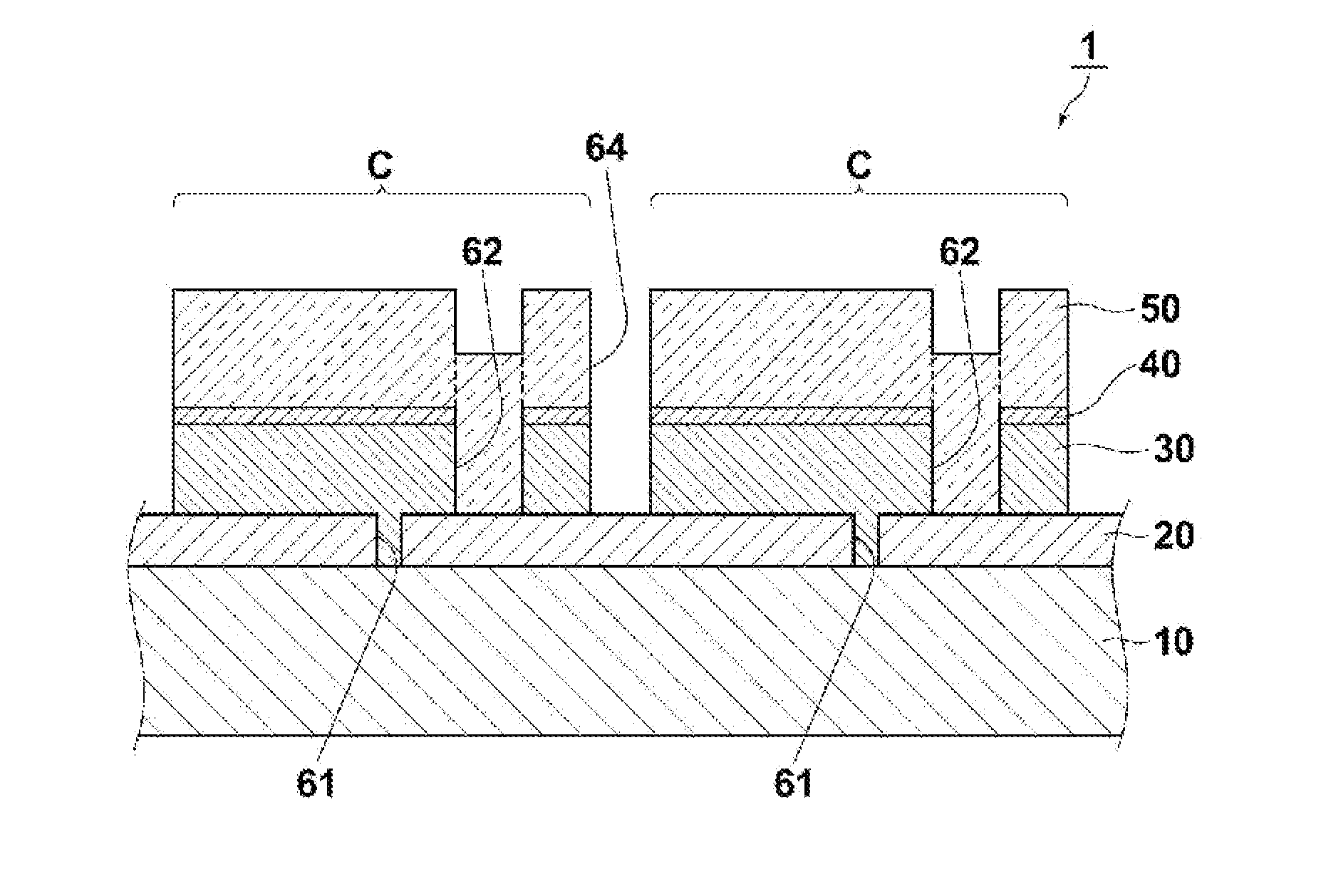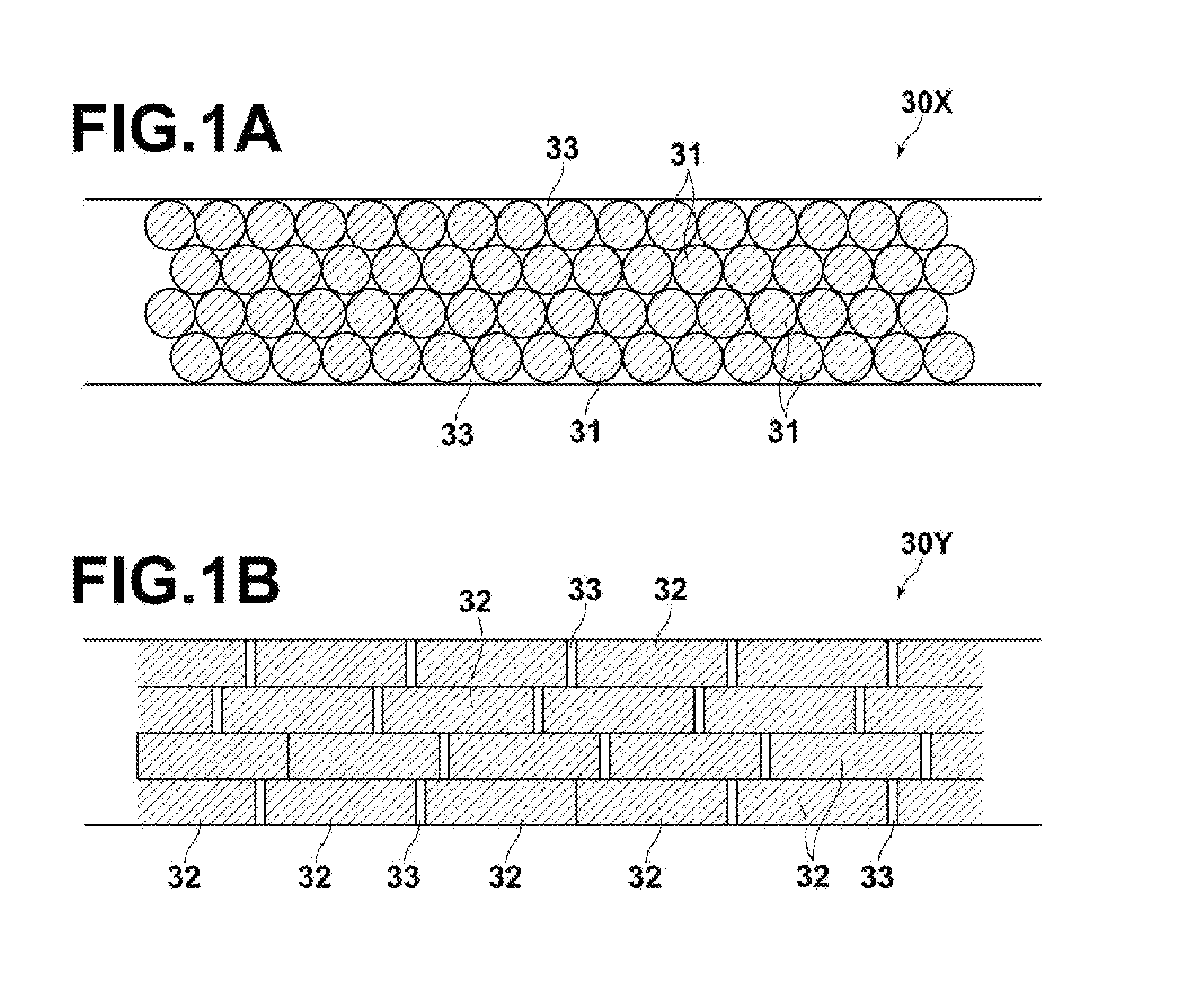Photoelectric conversion semiconductor layer, manufacturing method thereof, photoelectric conversion device, and solar cell
- Summary
- Abstract
- Description
- Claims
- Application Information
AI Technical Summary
Benefits of technology
Problems solved by technology
Method used
Image
Examples
example 1-1
[0174]A Mo lower electrode (rear electrode) was formed on a soda lime glass by RF sputtering. The thickness of the lower electrode was 1.0 μm. Next, a coating material dispersed with spherical particles P3 was coated on the substrate having the lower electrode formed thereon to provide a single layer of spherical particles P3 (Ga: 8.8 at %), and a coating material dispersed with spherical particles P2 was coated on the layer of spherical particles P3 to provide a single layer of spherical particles P2 (Ga: 6.5 at %). The dispersion medium was removed by dissolving in toluene and heat drying at 180° C. for 60 minutes. This yielded a CIGS photoelectric conversion layer of two particle layers having a single grating structure.
[0175]Next, a semiconductor film having a laminated structure was formed as a buffer layer. First, a CdS film was deposited by chemical deposition with a thickness of about 50 nm. The chemical deposition was performed by heating an aqueous solution containing nitr...
example 1-2
[0177]A photoelectric conversion device of the present invention was obtained in the same manner as in Example 1-1 except that the process for preparing the photoelectric conversion layer was changed as follows. A coating material dispersed with spherical particles P3 was coated on the substrate having the lower electrode formed thereon to provide a single layer of spherical particles P3 (Ga: 8.8 at %), then a coating material dispersed with spherical particles P2 was coated on the layer of spherical particles P3 to provide a single layer of spherical particles P2 (Ga: 6.5 at %), a coating material dispersed with spherical particles P1 was coated on the layer of spherical particles P2 to provide a single layer of spherical particles P1 (Ga: 4.3 at %), and a coating material dispersed with spherical particles P2 was coated on the layer of spherical particles P1 to provide a single layer of spherical particles P2 (Ga: 0.3 at %). The dispersion medium was removed by dissolving in tolue...
example 1-3
[0178]A photoelectric conversion device of the present invention was obtained in the same manner as in Example 1-1 except that the process for preparing the photoelectric conversion layer was changed as follows. A coating material dispersed with spherical particles P6 was coated on the substrate having the lower electrode formed thereon to provide a single layer of spherical particles P6 (Ag: 6.4 at %), then a coating material dispersed with spherical particles P5 was coated on the layer of spherical particles P6 to provide a single layer of spherical particles P5 (Ag: 9.7 at %), a coating material dispersed with spherical particles P4 was coated on the layer of spherical particles P5 to provide a single layer of spherical particles P4 (Ag: 12.9 at %), a coating material dispersed with spherical particles P5 was coated on the layer of spherical particles P4 to provide a single layer of spherical particles P5 (Ag: 9.7 at %). The dispersion medium was removed by dissolving in toluene ...
PUM
| Property | Measurement | Unit |
|---|---|---|
| Temperature | aaaaa | aaaaa |
| Fraction | aaaaa | aaaaa |
| Fraction | aaaaa | aaaaa |
Abstract
Description
Claims
Application Information
 Login to View More
Login to View More - R&D
- Intellectual Property
- Life Sciences
- Materials
- Tech Scout
- Unparalleled Data Quality
- Higher Quality Content
- 60% Fewer Hallucinations
Browse by: Latest US Patents, China's latest patents, Technical Efficacy Thesaurus, Application Domain, Technology Topic, Popular Technical Reports.
© 2025 PatSnap. All rights reserved.Legal|Privacy policy|Modern Slavery Act Transparency Statement|Sitemap|About US| Contact US: help@patsnap.com



